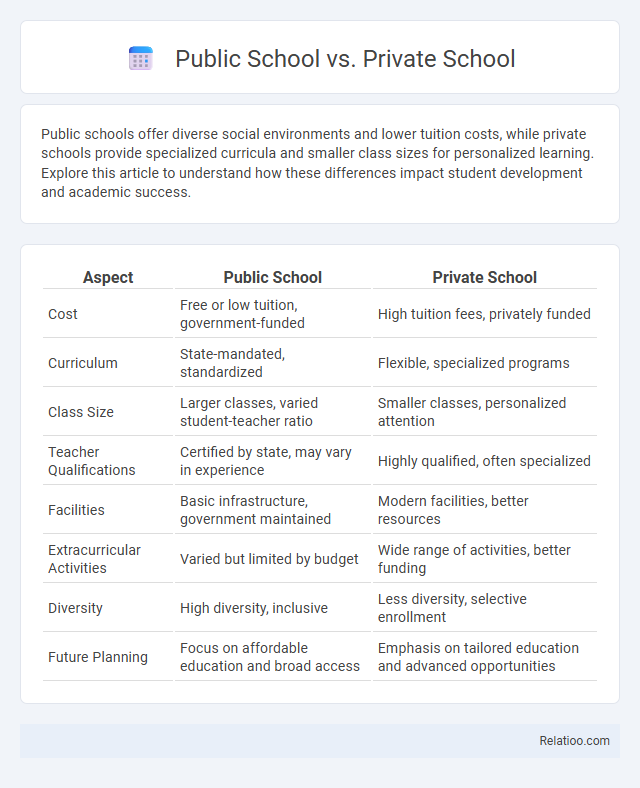Public schools offer diverse social environments and lower tuition costs, while private schools provide specialized curricula and smaller class sizes for personalized learning. Explore this article to understand how these differences impact student development and academic success.
Table of Comparison
| Aspect | Public School | Private School |
|---|---|---|
| Cost | Free or low tuition, government-funded | High tuition fees, privately funded |
| Curriculum | State-mandated, standardized | Flexible, specialized programs |
| Class Size | Larger classes, varied student-teacher ratio | Smaller classes, personalized attention |
| Teacher Qualifications | Certified by state, may vary in experience | Highly qualified, often specialized |
| Facilities | Basic infrastructure, government maintained | Modern facilities, better resources |
| Extracurricular Activities | Varied but limited by budget | Wide range of activities, better funding |
| Diversity | High diversity, inclusive | Less diversity, selective enrollment |
| Future Planning | Focus on affordable education and broad access | Emphasis on tailored education and advanced opportunities |
Introduction to Public and Private Schools
Public schools are government-funded institutions offering free education with standardized curricula and diverse student populations, ensuring accessible learning opportunities for all. Private schools operate independently with tuition fees, often providing specialized programs, smaller class sizes, and enhanced resources tailored to specific educational philosophies. Your education planning should consider these distinctions to align schooling options with your child's learning needs and financial capabilities.
Key Differences in Curriculum
Public schools typically follow state-mandated curricula emphasizing standardized testing and core subjects such as math, science, and language arts, ensuring consistency and accountability. Private schools often have the flexibility to offer specialized programs, advanced placement courses, and unique pedagogical approaches tailored to specific educational philosophies or religious affiliations. Education planning involves analyzing these curriculum differences to align a student's academic goals with the appropriate school type, balancing factors like curriculum rigor, extracurricular opportunities, and college preparation.
Class Size and Student-Teacher Ratio
Class size and student-teacher ratio significantly influence educational quality in public and private schools. Private schools typically offer smaller class sizes and lower student-teacher ratios, enhancing individualized attention and tailored instruction. In education planning, prioritizing reduced class sizes and favorable student-teacher ratios promotes improved academic outcomes and student engagement.
Admission Criteria and Processes
Public schools typically have open enrollment policies based on geographic zones, making admissions straightforward with minimal requirements. Private schools often require entrance exams, interviews, and submission of previous academic records, reflecting selective admission criteria. Education planning involves researching these diverse admission processes early to align applications with deadlines and specific school expectations.
Academic Performance and Outcomes
Public schools often provide diverse academic programs with standardized curricula that aim to meet state educational benchmarks, supporting consistent academic performance across demographics. Private schools typically offer specialized curricula, smaller class sizes, and tailored instruction, which can enhance student outcomes and college readiness. Education planning that considers school type, individual learning needs, and resource availability is crucial for optimizing academic performance and long-term educational success.
Extracurricular Opportunities
Public schools typically offer a wide range of extracurricular activities accessible to all students, promoting diversity and community involvement. Private schools often provide specialized programs with enhanced resources, allowing Your child to excel in niche areas such as arts, sports, or advanced academics. Carefully evaluating extracurricular opportunities is crucial in education planning to ensure that Your child's interests and talents are nurtured alongside academic growth.
Cost and Financial Considerations
Public schools often offer tuition-free education funded by local taxes, making them a cost-effective choice for families prioritizing affordability. Private schools require significant tuition fees, with additional costs for supplies and extracurricular activities, which can impact long-term financial planning. Effective education planning includes evaluating these expenditures alongside potential scholarships, financial aid, and the family's overall budget to ensure sustainable investment in a child's academic future.
Diversity and Social Environment
Public schools offer a diverse social environment reflecting the local community's demographic, promoting inclusivity and multicultural interactions. Private schools often have less diversity but provide tailored education planning with specific cultural or religious values. Your choice between public and private education profoundly influences your child's exposure to varied social perspectives and individualized academic support.
Facilities and Resources
Public schools often have larger class sizes and limited funding, which can restrict access to advanced facilities and cutting-edge educational resources. Private schools typically offer smaller classes and more investment in specialized facilities such as science labs, arts centers, and technology hubs, enhancing the learning environment. Effective education planning ensures equitable allocation of resources, balancing the material advantages of private institutions with the broader accessibility mandate of public schools.
Choosing the Right School for Your Child
Choosing the right school for your child involves evaluating key factors such as curriculum quality, class size, extracurricular opportunities, and available resources in public versus private schools. Public schools often provide diverse social environments and cost-effective education, while private schools may offer specialized programs and smaller class sizes that support personalized learning. Education planning includes assessing your child's learning needs, family budget, and long-term goals to ensure the selected school aligns with their academic and developmental success.

Infographic: Public School vs Private School
 relatioo.com
relatioo.com